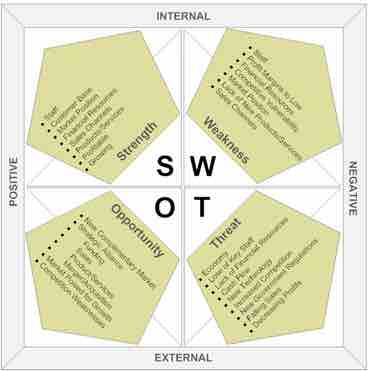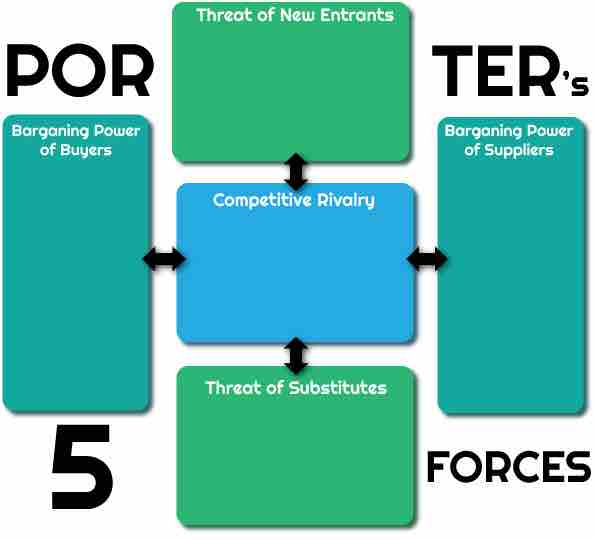Introduction
A marketing plan guides businesses on how to communicate the benefits of their products to potential customers.
The situation analysis, the 2nd step in a marketing plan, is critical in establishing a long-term relationship with customers. Managers use it to analyze the internal and external environment of an organization and the firm's own capabilities, customers, and business environment.
As described by the American Marketing Association, a situation analysis is "the systematic collection and study of past and present data to identify trends, forces, and conditions potentially to influence the performance of the business and to choose the appropriate strategies. "
The situation analysis consists of several methods of analysis: The 5Cs, SWOT and Porter's five forces analyses.
5C Analysis
A situation analysis is often referred to as a "3C analysis", but when extended to a 5C analysis it allows businesses to gain more information about the internal, macro and micro-environmental factors within the environment.
The 5C analysis is considered the most useful, comprehensive and common way to analyze the market environment.
The 5Cs are:
Company
Analysis of the company allows for evaluation of the company's objectives, strategies, and capabilities which indicate the strength of the business model, if there are areas needing improvement, and how an organization will fit with the external environment.
In addition to company goals and objectives, it includes an analysis of the firm's position, performance, and product line.
Competitors
The competitor analysis takes into consideration the competitor's position within the industry and the potential threat it may pose to other businesses. The main purpose of the competitor analysis is for businesses to analyze both the current and potential nature and capabilities of a competitor to be prepared to compete against them.
The competitor analysis looks at the following criteria: identity competitors, assessment of competitors, and future initiatives of competitors. The task of examining the competitor's financial and marketing performance is one of the responsibilities of a market analyst. It includes the strengths and weaknesses, the anticipated response to the company's marketing strategy, an analysis of growth and investment plans as well.
Customers
Customer analysis can be vast and complicated. Some companies conduct a PEST analysis which scans the external macro-environment in which the company operates. The important areas to analyze includes:
- Demographics
- Advertising most suitable for the demographic
- Market size and potential growth
- Customer wants and needs
- Motivation to buy the product
- Distribution channels (online, retail, and wholesale)
- Quantity and frequency of purchase
- Income level of customer
Collaborators
Collaborators are useful for businesses as they allow for an increase in the creation of ideas, as well as an increase in the likelihood of gaining more business opportunities.
Types of collaborators are:
- Agencies
- Suppliers
- Distributors
- Partnerships
Businesses must be able to identify whether the collaborator has the capabilities needed to help run the business as well as an analysis on the level of commitment needed for a collaborator-business relationship.
Climate
To fully understand the business climate, there are usually many different factors that can affect a business, and if researched well it will create a company that can respond well to change. An analysis on the climate is also known as the PEST analysis.
The types of climate that firms have to analyze are the:
- Political and regulatory environment
- Economic environment
- Social and cultural environment
- Technological environment
- Legislative environment
SWOT Analysis
A SWOT analysis is another method under the situation analysis that examines the Strengths and Weaknesses of a company (internal environment) as well as the Opportunities and Threats within the market (external environment) .

SWOT Analysis
A SWOT analysis can be a useful tool in conducting a situational analysis.
A SWOT analysis looks at both current and future situations, where they analyze their current strengths and weaknesses while looking for future opportunities and threats. The goal is to build on strengths as much as possible while reducing weaknesses. A future threat can be a potential weakness while a future opportunity can be a potential strength.
This analysis helps a company come up with a plan that keeps it prepared for a number of potential scenarios.
Porter's Five Forces Analysis
Porter five forces analysis is a framework for industry analysis and business strategy development. It draws upon industrial organization (IO) economics to derive five forces that determine the competitive intensity and therefore attractiveness of a market. Strategy consultants occasionally use the five forces model to scan for and identify competitors to conduct qualitatively evaluate a firm's strategic position. Ultimately, the primary purpose of the model is to help businesses compare and analyze their profitability and position at the line-of business, rather than industry group or industry sector level . It considers the following factors:

Porter's 5 forces
Firms use Porter's five forces to develop business strategy and conduct competitive analysis.
Threat of new entrants
Profitable markets that yield high returns will attract new firms. This results in many new entrants, which eventually will decrease profitability for all firms in the industry. Unless the entry of new firms can be blocked by incumbents, the abnormal profit rate will trend towards zero (perfect competition).
Bargaining power of buyers
The bargaining power of customers is also described as the market of outputs: the ability of customers to put the company under pressure, which also affects the customer's sensitivity to price changes (e.g. firm can implement loyalty program to reduce customers' buying power).
Bargaining power of suppliers
The bargaining power of suppliers is also described as the market of inputs. Suppliers of raw materials, components, labor, and services (such as expertise) to the company can be a source of power over the firm when there are few substitutes. Suppliers may refuse to work with the firm, or, charge excessively high prices for unique resources.
Threat of substitute product of services
The existence of products outside of the realm of the common product boundaries increases the propensity of customers to switch to alternatives. An example is the substitute of traditional phone with VoIP phone.
Rivals among existing competitors
For most industries, the intensity of competitive rivalry is the major determinant of the competitiveness of the industry.